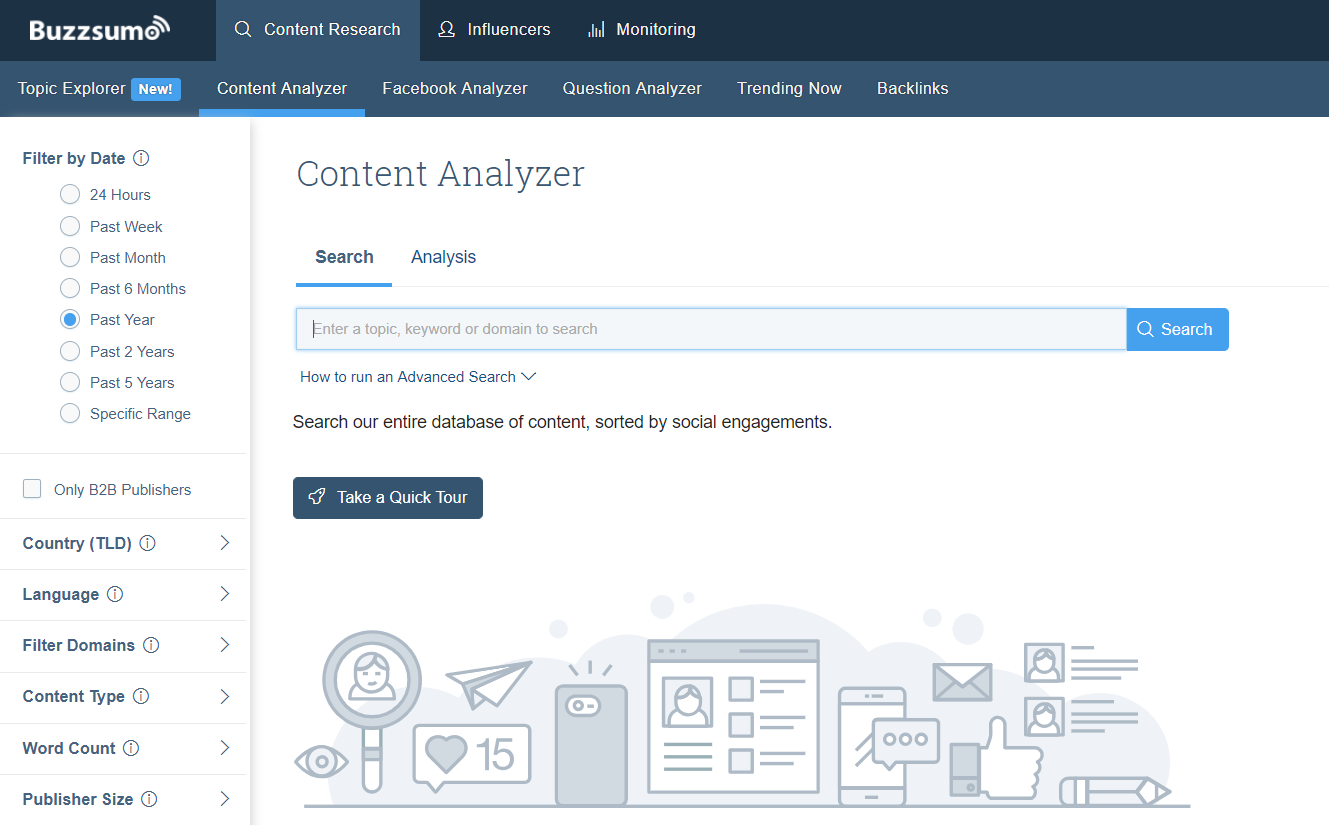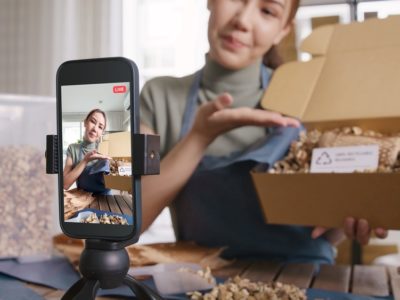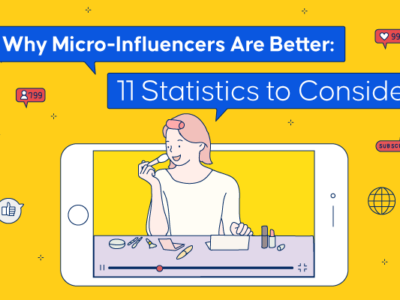Micro-influencers have around 1,000 to 10,000 followers, compared to the tens of thousands – or sometimes millions – their larger, rival influencers can enjoy.
In increasingly competitive markets, using micro-influencers is a marketing tactic that can help smaller businesses stand out.
A recent study found that micro-influencers are able to generate 60% greater engagement with marketing campaigns than bigger influencers with more followers.
The reason? Micro-influencers have a stronger bond with their followers, which means their advice is more trusted, valued and acted upon.
Before you begin your search for suitable micro-influencers, you need to know how to find the best ones for your brand. In this guide, you’ll learn exactly how to do this through easy-to-action tips, tricks, and actionable approaches.
Profile your customers for the best results
When it comes to finding the right micro-influencers for your customers, knowledge is power. For this reason, you’ll need to build a precise picture of your audience before approaching any targets. If you’re using an e-commerce platform like Shopify or WooCommerce, you’ll be able to mine the platform’s analytics and use clever apps to discover key customer data like:
- Gender
- Income
- Location
- Search volume for key pages
- Impressions from paid ads
- Conversion rates for key products and services
Once you’ve built up a picture of your customers, you can use Facebook Audiences and Twitter Analytics to do the same for your followers. Then, with a complete picture in your mind, you can build a comprehensive profile of your audience, segmenting them by interests so that finding the right influencers for your brand becomes a whole lot easier.
Start with your follower list
The easiest type of micro-influencer to recruit is one that already follows your brand. More often than not, they’re already engaged with your brand, familiar with your products or services, and will be happy you singled them out to collaborate as a potential partner. It will be time-consuming but turning your most engaged and popular Facebook, Instagram, and Twitter followers into micro-influencers is a cheaper way to:
- Build trust
- Improve brand awareness
- Extend reach within your target audience
- Build better partnerships
- Provide your target audience with content they will love
Recommended further reading: Why You Should Care About Instagram Stories.
Conduct keyword and hashtag research
If you’re searching further afield for micro-influencers, conducting keyword and hashtag research will help you build a list of viable targets. Hashtags help make content on social networks more shareable/accessible and look something like #iamahashtag.
You can build a list of relevant hashtags by feeding keywords into Hashtagify, a free tool that reveals trending hashtags for Twitter and Instagram.
As an example, let’s say you’re an independent fashion retailer; depending on your specialisms, you can use the following keywords to find the best hashtag suggestions:
- Plus size clothing
- Sports bras
- Slip on sneakers
- Cocktail dresses
From here, take your list of hashtags and plug them one by one into the search function of Twitter, Facebook (despite not being as prevalent on the platform, hashtags still work on Facebook), Instagram, etc. The results will reveal the profiles of people who have used these terms in their bios and a list of potential micro-influencers for you to consider.
Use the right tools
Manual searches using can turn into a grind. Luckily, there are lots of influencer search tools you can use as an alternative to find micro-influencers quicker. These tools allow you to search for micro-influencers based on industry-related terms and provide a great opportunity to reuse your hashtag and keyword research.
Some of the most popular and easiest to use include:
If you’re on a budget, however, BuzzSumo offers a free trial that will help you build a list of high-quality Twitter followers.

From the homepage (pictured above), click the ‘Influencers’ tab, enter the keywords related to your product, service or industry, then click ‘Search’. The results returned will provide a full list of the bloggers, publications, and brands that include your keywords in their bios. You can also filter your searches by page authority, the number of followers, retweet ratio, and more.
Recommended further reading: The Complete List of Free and Freemium Content Marketing Tools.
What to look for in a micro influencer
You should have a long list of potential micro-influencers now. The next step is to whittle it down into a short list of the most viable. Make sure you consider the following three things carefully:
Relevancy: Do your target micro-influencers create and share content? Or is their profile like a ghost town? Regular activity is a very important quality in a micro-influencer because it shows they’re dedicated to providing value for their followers and, by extension, your business.
Brand match: Does the tone of voice, style, and presentation provide a good fit for your brand? Although it will be near to impossible to find an exact match, you’ll want the sponsored post that sits on their blog or social feed to look natural and not overly promotional.
Engagement: Engagement is a two-way process between influencer and follower and a vital part of making sponsored content a success. Do the posts of your target influencer get likes and comments? And does the influencer respond to them? You must ask yourself these two questions when finding the right micro-influencer for your campaign.
How to approach micro-influencers
Now you’ve done the hardest part, it’s time to reach out to your target micro-influencers. To do this effectively, use the following three-step blueprint:
-
Be simple and concise
Good micro-influencers can receive hundreds of pitches a week. If they open your message and they don’t see the value of working with you immediately, they’re unlikely to keep reading, never mind respond.
-
Show how you can help them
Following on from point one, if you’re not offering your target influencer something that is mutually beneficial, they’re less likely to respond. You want a micro-influencer to help grow your brand so they’re going to want something in return, whether it’s money or some other incentive.
-
Give a deadline
Without being pushy or rude, give them a deadline to respond. You can’t wait indefinitely for a response, and most micro-influencers will know if they’re interested straight away. In the majority of cases, a week will be more than enough for them to make up their mind about whether they want to work with you.
Don’t be afraid to give micro-influencers creative freedom
If you’ve followed the advice above, you should have a list of viable micro-influencers to reach out to. Now, you need to trust them.
The best micro-influencers are successful for a reason. They have found their niche, discovered how to engage their audience and are great at creating content. You’re probably exploring the idea of using micro-influencers because you’ve discovered that consumers are more likely to trust recommendations from their peers over brands.
It might be painful-slash-stressful to relinquish control but for the best results, you’ll need to give the micro-influencers you collaborate with creative freedom.
Notes on achieving the best return on investment
Final words on maintaining momentum and getting a good return on investment: make sure you’re tracking prices, engagement, and eventual sales and sign-ups.
Did you know that on average, influencers charge $100 for every 10,000 followers?
Factors such as content quality, campaign types, and engagement rates are going to affect this cost. However, as a rule, micro-influencers are much more affordable than macro influencers with a larger number of followers and are a great tactic for ecommerce scale-ups, service-based businesses, and pretty much anyone with a desire to build up a credible digital presence and social proof.
Three micro-influencer ROI hacks
- Partner with influencers during the ‘off-season’. They will be inundated with brand requests around the holiday season, but if you get in touch during a fallow period, you might get a better deal.
- Already analyzed the top competition and need to widen your sphere of influence? Why not try looking at websites for sale as a source for inspiration? More often than not, they’re grown from scratch by DIY entrepreneurs who have grown their customer base by building a deeper connection with their audience than their more established rivals. As a result, scanning their blog and social media pages for micro-influencer collaborations is a great hack for researching campaign ideas you can use to achieve similar success. You can also go ahead and ‘steal’ any relevant influencers for your own brand…
- Integrating exclusive sales and discount vouchers into your micro-influencer campaigns will help make them ‘stick’ and will also push up the value of collaborations for your brand. If you become known for generous offers and deals, the community will get behind your posts with more enthusiasm. Spend a little to get a whole lot more. Affiliate marketing company Awin launched improved influencer attribution tracking in 2018 — it’s a tactic that’s hotting up in the affiliate world along with a host of affiliate marketing tools.
Wrap Up
Leveraging micro-influencers to grow your brand is extremely effective – if you do your homework on how to find the right ones. Using the tips, tricks, and techniques above will help you discover affordable advocates for your brand, product or services, while simultaneously extending your reach.





